This tutorial describes how to use ListView together with activities and fragments in Android.
1. Using lists in Android
The display of elements in a list is a common pattern in mobile applications. The user sees a list of items and can scroll through them. Such an activity is depicted in the following picture.
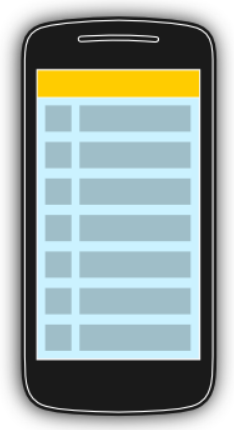
Typically the user interacts with the list via the toolbar, for example, via a button which refreshes the list. Individual list items can be selected. This selection can update the toolbar or can trigger a detailed screen for the selection. The following graphic sketches that. On the selection of a list item another activity is started.
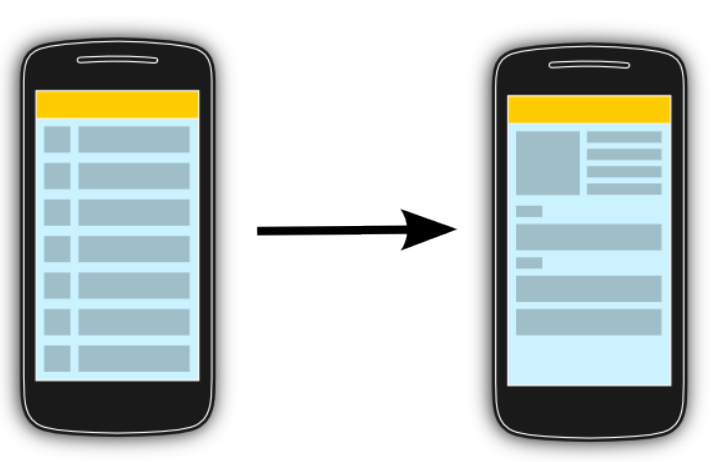
2. Android and the ListView widget
2.1. Views for handling lists
Android provides the ListView and the ExpandableListView classes that are capable of displaying a scrollable list of items.
The ExpandableListView class supports a grouping of items.
2.2. Possible input types for lists
The input of a list (items in the list) can be arbitrary Java objects.
The adapter extracts the correct data from the data object and assigns this data to the views in the row of the ListView.
These items are typically called the data model of the list. An adapter can receive data as input.
2.3. Adapters
An adapter manages the data model and adapts it to the individual entries in the widget.
An adapter extends the BaseAdapter class.
Every line in the widget displaying the data consists of a layout that can be as complex as you want. A typical line in a list has an image on the left side and two text lines in the middle as depicted in the following graphic.

A layout file for such a line might look like the following.
<RelativeLayout xmlns:android="http://schemas.android.com/apk/res/android"
android:layout_width="fill_parent"
android:layout_height="?android:attr/listPreferredItemHeight"
android:padding="6dip" >
<ImageView
android:id="@+id/icon"
android:layout_width="wrap_content"
android:layout_height="fill_parent"
android:layout_alignParentBottom="true"
android:layout_alignParentTop="true"
android:layout_marginRight="6dip"
android:contentDescription="TODO"
android:src="@drawable/ic_launcher" />
<TextView
android:id="@+id/secondLine"
android:layout_width="fill_parent"
android:layout_height="26dip"
android:layout_alignParentBottom="true"
android:layout_alignParentRight="true"
android:layout_toRightOf="@id/icon"
android:ellipsize="marquee"
android:maxLines="1"
android:text="Description"
android:textSize="12sp" />
<TextView
android:id="@+id/firstLine"
android:layout_width="fill_parent"
android:layout_height="wrap_content"
android:layout_above="@id/secondLine"
android:layout_alignParentRight="true"
android:layout_alignParentTop="true"
android:layout_alignWithParentIfMissing="true"
android:layout_toRightOf="@id/icon"
android:gravity="center_vertical"
android:text="Example application"
android:textSize="16sp" />
</RelativeLayout>The adapter would inflate the layout for each row in its getView() method and assign the data to the individual views in the row.
The adapter is assigned to the ListView via the setAdapter method on the ListView object.
Adapters are not only used by ListView, but also by other views which extend AdapterView as, for example, Spinner, GridView, Gallery and StackView.
|
2.4. Filtering and sorting
The filtering and sorting of the data is handled by the adapter. You need to implement the logic in your custom adapter implementation.
2.5. Data updates in the adapter
The notifyDataSetChanged() method on the adapter is called if the data has changed or if new data is available.
The notifyDataSetInvalidated() method is called if the data is not available anymore.
2.6. Listener
To react to selections in the list, set an OnItemClickListener to your ListView.
listView.setOnItemClickListener(new OnItemClickListener() {
@Override
public void onItemClick(AdapterView<?> parent, View view,
int position, long id) {
Toast.makeText(getApplicationContext(),
"Click ListItem Number " + position, Toast.LENGTH_LONG)
.show();
}
});3. Default adapter
3.1. Default platform adapter
Android provides default adapter implementations; the most important are ArrayAdapter and CursorAdapter.
ArrayAdapter can handle data based on Arrays or java.util.List.
SimpleCursorAdapter can handle database related data.
3.2. Using ArrayAdapter
The ArrayAdapter class can handle a list or arrays of Java objects as input.
Every Java object is mapped to one row.
By default, it maps the toString() method of the object to a view in the row layout.
You can define the ID of the view in the constructor of the ArrayAdapter otherwise the android.R.id.text1 ID is used as default.
The ArrayAdapter class allows to remove all elements in its underlying data structure with the clear() method call.
You can then add new elements via the add() method or a Collection via the addAll() method.
You can also directly modify the underlying data structure and call the notifyDataSetChanged() method on the adapter to notify it about the changes in data.
If you want to change the data in your adapter, the underlying data structure must support this operation.
This is, for example, the case for the ArrayList class, but not for arrays.
|
3.3. ListView example with ArrayAdapter
The following listing shows a layout file called activity_listviewexampleactivity.xml which includes a ListView.
<ListView xmlns:android="http://schemas.android.com/apk/res/android"
android:id="@+id/listview"
android:layout_width="wrap_content"
android:layout_height="wrap_content" />The following example shows the usage of the ListView view in an activity.
It uses a default layout from the Android platform for the row layout.
It also demonstrates the removal of list items and uses animations for the removal.
package com.vogella.android.listview.withanimation;
public class ListViewExampleActivity extends Activity {
@Override
protected void onCreate(Bundle savedInstanceState) {
super.onCreate(savedInstanceState);
setContentView(R.layout.activity_listviewexampleactivity);
final ListView listview = (ListView) findViewById(R.id.listview);
String[] values = new String[] { "Android", "iPhone", "WindowsMobile",
"Blackberry", "WebOS", "Ubuntu", "Windows7", "Max OS X",
"Linux", "OS/2", "Ubuntu", "Windows7", "Max OS X", "Linux",
"OS/2", "Ubuntu", "Windows7", "Max OS X", "Linux", "OS/2",
"Android", "iPhone", "WindowsMobile" };
final ArrayList<String> list = new ArrayList<String>();
for (int i = 0; i < values.length; ++i) {
list.add(values[i]);
}
final StableArrayAdapter adapter = new StableArrayAdapter(this,
android.R.layout.simple_list_item_1, list);
listview.setAdapter(adapter);
listview.setOnItemClickListener(new AdapterView.OnItemClickListener() {
@Override
public void onItemClick(AdapterView<?> parent, final View view,
int position, long id) {
final String item = (String) parent.getItemAtPosition(position);
view.animate().setDuration(2000).alpha(0)
.withEndAction(new Runnable() {
@Override
public void run() {
list.remove(item);
adapter.notifyDataSetChanged();
view.setAlpha(1);
}
});
}
});
}
private class StableArrayAdapter extends ArrayAdapter<String> {
HashMap<String, Integer> mIdMap = new HashMap<String, Integer>();
public StableArrayAdapter(Context context, int textViewResourceId,
List<String> objects) {
super(context, textViewResourceId, objects);
for (int i = 0; i < objects.size(); ++i) {
mIdMap.put(objects.get(i), i);
}
}
@Override
public long getItemId(int position) {
String item = getItem(position);
return mIdMap.get(item);
}
@Override
public boolean hasStableIds() {
return true;
}
}
}4. Custom adapter implementations
4.1. Developing a custom adapter
The ArrayAdapter is limited as it supports only the mapping of toString() to one view in the row layout.
To control the data assignment and to support several views, you have to create your custom adapter implementation.
For this you would extend an existing adapter implementation or subclass the BaseAdapter class directly.
Frequently you extend ArrayAdapter to write a custom adapter, as this is simpler than extending BaseAdapter directly.
|
4.2. Preparing a row for the list
The adapter needs to create a layout for each row of the list.
The ListView instance calls the getView() method on the adapter for each data element.
In this method the adapter creates the row layout and maps the data to the views in the layout.
This root of the layout is typically a ViewGroup (layout manager) and contains several other views, e.g., an ImageView and a TextView.
The following graphic shows a list with different layouts for odd and even rows.

Within the getView() method you would inflate an XML based layout and then set the content of the individual views based on the Java object for this row.
To inflate the XML layout file, you can use the LayoutInflator system service.
This layout inflator service can get accessed via the getLayoutInflator() method of the activity or via the context.getSystemService(Context.LAYOUT_INFLATER_SERVICE) method call.
|
After the adapter inflated the layout, it searches for the relevant views in the layout and fills them with the data.
The individual elements in the layout can be found via the findViewById() method call on the top level view.
4.3. Example of a custom adapter
The following code shows an implementation of a custom adapter. This adapter assumes that you have two png files (no.png and ok.png) in one of your directory]]res/drawable folders. The coding inflates an XML layout file, finds the relevant views in the layout and sets their content based on the input data.
package de.vogella.android.listactivity;
import android.content.Context;
import android.view.LayoutInflater;
import android.view.View;
import android.view.ViewGroup;
import android.widget.ArrayAdapter;
import android.widget.ImageView;
import android.widget.TextView;
public class MySimpleArrayAdapter extends ArrayAdapter<String> {
private final Context context;
private final String[] values;
public MySimpleArrayAdapter(Context context, String[] values) {
super(context, -1, values);
this.context = context;
this.values = values;
}
@Override
public View getView(int position, View convertView, ViewGroup parent) {
LayoutInflater inflater = (LayoutInflater) context
.getSystemService(Context.LAYOUT_INFLATER_SERVICE);
View rowView = inflater.inflate(R.layout.rowlayout, parent, false);
TextView textView = (TextView) rowView.findViewById(R.id.label);
ImageView imageView = (ImageView) rowView.findViewById(R.id.icon);
textView.setText(values[position]);
// change the icon for Windows and iPhone
String s = values[position];
if (s.startsWith("iPhone")) {
imageView.setImageResource(R.drawable.no);
} else {
imageView.setImageResource(R.drawable.ok);
}
return rowView;
}
}4.4. Updating the data model from the adapter
The row can also contain views which interact with the underlying data model via the adapter.
For example, you can have a Checkbox in your row layout and if the Checkbox is selected, the underlying data is changed.
5. ListActivity and ListFragment
5.1. Default container for using ListView
Android provides specialized fragment and activity classes to simplify list handling.
The classes are the ListActivity class, if you want to use lists in activities, and the ListFragment class, if you want to use lists in fragments.
You do not have to assign a layout to these elements.
If you do not define a layout, the activity or fragment contains a single ListView by default.
ListActivity and ListFragment also allow you to override a onListItemClick() method for handling selection of list items.
Both classes allow you to set the adapter to the default ListView via the setListAdapter() method.
The following example code shows a simple ListFragment implementation.
package de.vogella.android.fragments;
import android.content.Intent;
import android.os.Bundle;
import android.view.View;
import android.widget.ArrayAdapter;
import android.widget.ListView;
import android.app.ListFragment;
public class MyListFragment extends ListFragment {
@Override
public void onActivityCreated(Bundle savedInstanceState) {
super.onActivityCreated(savedInstanceState);
String[] values = new String[] { "Android", "iPhone", "WindowsMobile",
"Blackberry", "WebOS", "Ubuntu", "Windows7", "Max OS X",
"Linux", "OS/2" };
ArrayAdapter<String> adapter = new ArrayAdapter<String>(getActivity(),
android.R.layout.simple_list_item_1, values);
setListAdapter(adapter);
}
@Override
public void onListItemClick(ListView l, View v, int position, long id) {
// TODO implement some logic
}
}The next example code demonstrates the usage of a ListActivity.
package de.vogella.android.listactivity;
import android.app.ListActivity;
import android.os.Bundle;
import android.widget.ArrayAdapter;
public class MyListActivity extends ListActivity {
public void onCreate(Bundle icicle) {
super.onCreate(icicle);
String[] values = new String[] { "Android", "iPhone", "WindowsMobile",
"Blackberry", "WebOS", "Ubuntu", "Windows7", "Max OS X",
"Linux", "OS/2" };
ArrayAdapter<String> adapter = new ArrayAdapter<String>(this,
android.R.layout.simple_list_item_1, values);
setListAdapter(adapter);
}
}5.2. ListActivity and custom layout
You can use a custom layout with ListActivity or ListFragment.
In this case the fragment or activity searches in the provided layout for a ListView with the predefined android:id attribute set to @android:id/list.
This usage is demonstrated by the following code snippet.
<ListView
android:id="@android:id/list"
android:layout_width="match_parent"
android:layout_height="wrap_content" >
</ListView>
If you do not use this ID or do not include a ListView into your layout, the application crashes once you try to display the activity or the fragment.
|
5.3. Placeholder for an empty list
You can also use a view with the @android:id/empty ID in your layout.
The corresponding activity and fragment shows this view automatically if the ListView is empty and hides it otherwise.
For example, you could display an error message in such a view.
6. Exercise: Use ListView and ListActivity
The following exercise demonstrates how to use a ListView in an ListActivity.
You use the predefined ArrayAdapter class and an existing Android layout for the rows.
Create a new Android project called de.vogella.android.listactivity with the activity called MyListActivity.
Change MyListActivity class based on the following code example.
Note that the setContentView() method is not used.
package de.vogella.android.listactivity;
import android.app.ListActivity;
import android.os.Bundle;
import android.view.View;
import android.widget.ArrayAdapter;
import android.widget.ListView;
import android.widget.Toast;
public class MyListActivity extends ListActivity {
public void onCreate(Bundle icicle) {
super.onCreate(icicle);
String[] values = new String[] { "Android", "iPhone", "WindowsMobile",
"Blackberry", "WebOS", "Ubuntu", "Windows7", "Max OS X",
"Linux", "OS/2" };
ArrayAdapter<String> adapter = new ArrayAdapter<String>(this,
android.R.layout.simple_list_item_1, values);
setListAdapter(adapter);
}
@Override
protected void onListItemClick(ListView l, View v, int position, long id) {
String item = (String) getListAdapter().getItem(position);
Toast.makeText(this, item + " selected", Toast.LENGTH_LONG).show();
}
}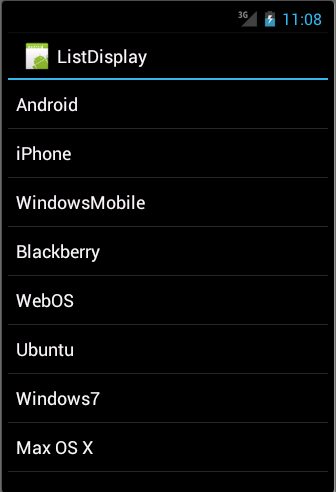
7. Exercise: ListActivity with custom layout
In our example your will define your layout for the rows and use it in your adapter.
Create the rowlayout.xml layout file in the directory]]res/layout folder of the de.vogella.android.listactivity project.
<?xml version="1.0" encoding="utf-8"?>
<LinearLayout xmlns:android="http://schemas.android.com/apk/res/android"
android:layout_width="wrap_content"
android:layout_height="wrap_content" >
<ImageView
android:id="@+id/icon"
android:layout_width="22px"
android:layout_height="22px"
android:layout_marginLeft="4px"
android:layout_marginRight="10px"
android:layout_marginTop="4px"
android:src="@drawable/ic_launcher" >
</ImageView>
<TextView
android:id="@+id/label"
android:layout_width="wrap_content"
android:layout_height="wrap_content"
android:text="@+id/label"
android:textSize="20px" >
</TextView>
</LinearLayout>Change your activity so that it uses the new layout.
package de.vogella.android.listactivity;
import android.app.ListActivity;
import android.os.Bundle;
import android.view.View;
import android.widget.ArrayAdapter;
import android.widget.ListView;
import android.widget.Toast;
public class MyListActivity extends ListActivity {
public void onCreate(Bundle icicle) {
super.onCreate(icicle);
String[] values = new String[] { "Android", "iPhone", "WindowsMobile",
"Blackberry", "WebOS", "Ubuntu", "Windows7", "Max OS X",
"Linux", "OS/2" };
// use your custom layout
ArrayAdapter<String> adapter = new ArrayAdapter<String>(this,
R.layout.rowlayout, R.id.label, values);
setListAdapter(adapter);
}
@Override
protected void onListItemClick(ListView l, View v, int position, long id) {
String item = (String) getListAdapter().getItem(position);
Toast.makeText(this, item + " selected", Toast.LENGTH_LONG).show();
}
}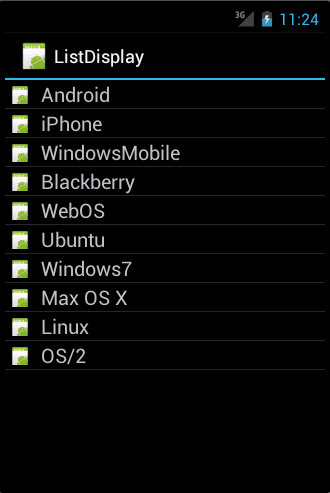
8. Tutorial: Implementing your customer adapter
The following uses two images "no.png" and "ok.png". I placed them in the "res/drawable-mdpi" folder. You must create your own icons. If you do not find any icons just copy "icon.png" and use a drawing program to change it a little bit and create a second one.
Create the class MySimpleArrayAdapter which will serve as our adapter.
package de.vogella.android.listactivity;
import android.content.Context;
import android.view.LayoutInflater;
import android.view.View;
import android.view.ViewGroup;
import android.widget.ArrayAdapter;
import android.widget.ImageView;
import android.widget.TextView;
public class MySimpleArrayAdapter extends ArrayAdapter<String> {
private final Context context;
private final String[] values;
public MySimpleArrayAdapter(Context context, String[] values) {
super(context, R.layout.rowlayout, values);
this.context = context;
this.values = values;
}
@Override
public View getView(int position, View convertView, ViewGroup parent) {
LayoutInflater inflater = (LayoutInflater) context
.getSystemService(Context.LAYOUT_INFLATER_SERVICE);
View rowView = inflater.inflate(R.layout.rowlayout, parent, false);
TextView textView = (TextView) rowView.findViewById(R.id.label);
ImageView imageView = (ImageView) rowView.findViewById(R.id.icon);
textView.setText(values[position]);
// Change the icon for Windows and iPhone
String s = values[position];
if (s.startsWith("Windows7") || s.startsWith("iPhone")
|| s.startsWith("Solaris")) {
imageView.setImageResource(R.drawable.no);
} else {
imageView.setImageResource(R.drawable.ok);
}
return rowView;
}
}To use this adapter, change the activity to the following.
package de.vogella.android.listactivity;
import android.app.ListActivity;
import android.os.Bundle;
public class MyListActivity extends ListActivity {
public void onCreate(Bundle icicle) {
super.onCreate(icicle);
String[] values = new String[] { "Android", "iPhone", "WindowsMobile",
"Blackberry", "WebOS", "Ubuntu", "Windows7", "Max OS X",
"Linux", "OS/2" };
MySimpleArrayAdapter adapter = new MySimpleArrayAdapter(this, values);
setListAdapter(adapter);
}
}If you run this example you should get a list with different icons for the certain elements.
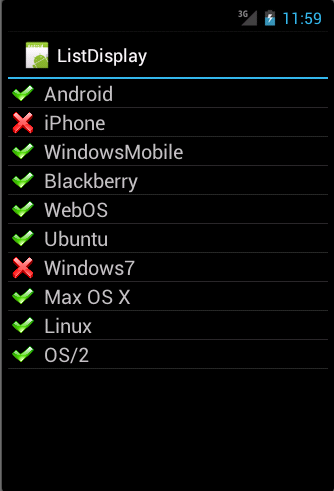
9. ListViews and performance
9.1. Motivation
Performance is especially important on Android as users expect fast reaction times. Compared to desktop computers an Android device is relatively slow from the hardware perspective.
This part describes how to reduce these operations to implement your custom list adapter efficiently.
The default Android adapters like ArrayAdapter are already performance optimized.
9.2. Time consuming operations
Every view which gets inflated from an XML layout file will result in a Java object. Inflating layouts and creating Java objects are expensive with regards to time and memory consumption.
In addition using the findViewById() method is relatively time consuming, even though it is not as bad as XML inflating.
9.3. Avoiding layout inflation and object creation
A ListView typically contains more data than the number of displayed rows.
If the user scrolls the list, then the rows and their associated views will be scrolled out of the visible area.
The Java objects that represent the rows can be reused for newly visible rows.
If Android determines that a row is not visible anymore, it allows the getView() of the adapter method to reuse the associated view via the convertView parameter.
The adapter can assign new data to the views contained in the view hierarchy of the convertView.
This avoids inflating an XML file and creating new Java objects.
In case Android cannot reuse a row, the Android system passes null to the convertView parameter.
Therefore the adapter implementation needs to check for this.
9.4. View holder pattern
A ViewHolder implementation allows to avoid the findViewById() method in an adapter.
A ViewHolder class is typically a static inner class in your adapter which holds references to the relevant views in your layout.
This reference is assigned to the row view as a tag via the setTag() method.
If we receive a convertView object, we can get the instance of the ViewHolder via the getTag() method and assign the new attributes to the views via the ViewHolder reference.
While this sounds complex this is approximately 15 % faster than using the findViewById() method.
9.5. Example
The following code shows a performance optimized adapter implementation which reuses existing views and implements the holder pattern.
package de.vogella.android.listactivity;
import android.app.Activity;
import android.view.LayoutInflater;
import android.view.View;
import android.view.ViewGroup;
import android.widget.ArrayAdapter;
import android.widget.ImageView;
import android.widget.TextView;
public class MyPerformanceArrayAdapter extends ArrayAdapter<String> {
private final Activity context;
private final String[] names;
static class ViewHolder {
public TextView text;
public ImageView image;
}
public MyPerformanceArrayAdapter(Activity context, String[] names) {
super(context, R.layout.rowlayout, names);
this.context = context;
this.names = names;
}
@Override
public View getView(int position, View convertView, ViewGroup parent) {
View rowView = convertView;
// reuse views
if (rowView == null) {
LayoutInflater inflater = context.getLayoutInflater();
rowView = inflater.inflate(R.layout.rowlayout, null);
// configure view holder
ViewHolder viewHolder = new ViewHolder();
viewHolder.text = (TextView) rowView.findViewById(R.id.TextView01);
viewHolder.image = (ImageView) rowView
.findViewById(R.id.ImageView01);
rowView.setTag(viewHolder);
}
// fill data
ViewHolder holder = (ViewHolder) rowView.getTag();
String s = names[position];
holder.text.setText(s);
if (s.startsWith("Windows7") || s.startsWith("iPhone")
|| s.startsWith("Solaris")) {
holder.image.setImageResource(R.drawable.no);
} else {
holder.image.setImageResource(R.drawable.ok);
}
return rowView;
}
}10. Storing the selection of a view
By default, a ListView has no selection mode active.
You can activate it via the setChoiceMode() method call.
Pass ListView.CHOICE_MODE_MULTIPLE for multiple selections or ListView.CHOICE_MODE_SINGLE for single selections to this method.
To get the selected items of a ListView, use the getCheckedItemPosition() for a single selection method or listView.getCheckedItemPositions() for multiple selections.
If you have stable ID, you could also use the getCheckedItemIds() method to get the selected IDs.
Android already provides a default layout for this: the android.R.layout.simple_list_item_multiple_choice layout that contains a configured CheckedTextView view.
The following activities demonstrate how to use these selection modes.
If you use these modes, the ListView stores the selected values.
It is not persisted in your data model.
package com.vogella.android.listview.selection.multi;
import android.app.ListActivity;
import android.os.Bundle;
import android.view.Menu;
import android.view.MenuItem;
import android.widget.ArrayAdapter;
import android.widget.ListView;
import android.widget.Toast;
import com.vogella.android.listview.selection.R;
public class MainActivity extends ListActivity {
@Override
protected void onCreate(Bundle savedInstanceState) {
super.onCreate(savedInstanceState);
String[] values = new String[] { "a", "b", "c", "d", "e", "f", "g",
"h", "i", "j", "k", "l", "m", "n", "o", "p", "q", "r", "s",
"t", "u", "w", "x", "y", "z" };
ArrayAdapter<String> adapter = new ArrayAdapter<String>(this,
android.R.layout.simple_list_item_multiple_choice, values);
setListAdapter(adapter);
getListView().setChoiceMode(ListView.CHOICE_MODE_MULTIPLE);
}
@Override
public boolean onCreateOptionsMenu(Menu menu) {
getMenuInflater().inflate(R.menu.main, menu);
return true;
}
@Override
public boolean onOptionsItemSelected(MenuItem item) {
Toast.makeText(this,
String.valueOf(getListView().getCheckedItemCount()),
Toast.LENGTH_LONG).show();
return true;
}
}package com.vogella.android.listview.selection.single;
import android.app.ListActivity;
import android.os.Bundle;
import android.view.Menu;
import android.view.MenuItem;
import android.widget.ArrayAdapter;
import android.widget.ListView;
import android.widget.Toast;
public class MainActivity extends ListActivity {
@Override
protected void onCreate(Bundle savedInstanceState) {
super.onCreate(savedInstanceState);
String[] values = new String[] { "a", "b", "c", "d", "e", "f", "g",
"h", "i", "j", "k", "l", "m", "n", "o", "p", "q", "r", "s",
"t", "u", "w", "x", "y", "z" };
ArrayAdapter<String> adapter = new ArrayAdapter<String>(this,
android.R.layout.simple_list_item_single_choice, values);
setListAdapter(adapter);
getListView().setChoiceMode(ListView.CHOICE_MODE_SINGLE);
}
@Override
public boolean onCreateOptionsMenu(Menu menu) {
getMenuInflater().inflate(R.menu.main, menu);
return true;
}
@Override
public boolean onOptionsItemSelected(MenuItem item) {
Toast.makeText(this,
String.valueOf(getListView().getCheckedItemCount()),
Toast.LENGTH_LONG).show();
return true;
}
}11. Contextual action mode for ListViews
The following assumes that you are already familiar with the concept of the ActionBar and contextual action mode in general.
This part will explain how to use contextual action mode for a ListView selection.
To assign a contextual action mode to a long click on an individual item, use the method setOnItemLongClickListener() on ListView.
This method includes information about the selected item.
In this method you can start the ActionMode.
The following examples demonstrate that.
It assumes that you have a menu XML file defined called rowselection.xml and that this menu contains one entry with the @+id/menuitem1_show ID.
package de.vogella.android.listactivity;
import android.app.ListActivity;
import android.os.Bundle;
import android.view.ActionMode;
import android.view.Menu;
import android.view.MenuInflater;
import android.view.MenuItem;
import android.view.View;
import android.widget.AdapterView;
import android.widget.AdapterView.OnItemLongClickListener;
import android.widget.Toast;
public class MyListActivityActionbar extends ListActivity
implements ActionMode.Callback {
protected Object mActionMode;
public int selectedItem = -1;
@Override
public void onCreate(Bundle icicle) {
super.onCreate(icicle);
String[] values = new String[] { "Android",
"iPhone", "WindowsMobile",
"Blackberry", "WebOS", "Ubuntu",
"Windows7", "Max OS X", "Linux", "OS/2",
"Ubuntu", "Windows7", "Max OS X",
"Linux", "OS/2", "Ubuntu",
"Windows7", "Max OS X",
"Linux", "OS/2" };
MySimpleArrayAdapter adapter = new MySimpleArrayAdapter(this, values);
setListAdapter(adapter);
getListView().setOnItemLongClickListener(new OnItemLongClickListener() {
@Override
public boolean onItemLongClick(AdapterView<?> parent, View view, int position, long id) {
if (mActionMode != null) {
return false;
}
selectedItem = position;
// Start the CAB using the ActionMode.Callback defined above
mActionMode = MyListActivityActionbar.this.startActionMode(MyListActivityActionbar.this);
view.setSelected(true);
return true;
}
});
}
private void show() {
Toast.makeText(MyListActivityActionbar.this, String.valueOf(selectedItem), Toast.LENGTH_LONG).show();
}
// Called when the action mode is created; startActionMode() was called
@Override
public boolean onCreateActionMode(ActionMode mode, Menu menu) {
// Inflate a menu resource providing context menu items
MenuInflater inflater = mode.getMenuInflater();
// Assumes that you have "contexual.xml" menu resources
inflater.inflate(R.menu.rowselection, menu);
return true;
}
// Called each time the action mode is shown. Always called after
// onCreateActionMode, but
// may be called multiple times if the mode is invalidated.
@Override
public boolean onPrepareActionMode(ActionMode mode, Menu menu) {
return false; // Return false if nothing is done
}
// Called when the user selects a contextual menu item
@Override
public boolean onActionItemClicked(ActionMode mode, MenuItem item) {
switch (item.getItemId()) {
case R.id.menuitem1_show:
show();
// Action picked, so close the CAB
mode.finish();
return true;
default:
return false;
}
}
// Called when the user exits the action mode
@Override
public void onDestroyActionMode(ActionMode mode) {
mActionMode = null;
selectedItem = -1;
}
}If you start your application and long press on an item in the list, you will get your contextual action bar.
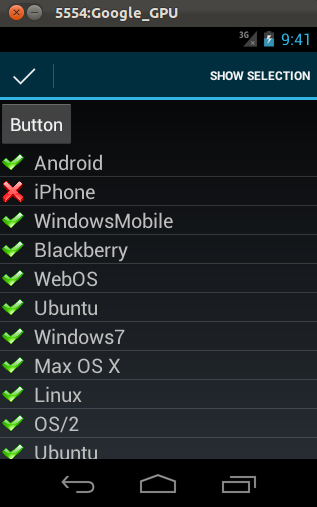
12. Implementing undo for an action
12.1. When should you offer an undo action?
It is a good practice to allow the user to undo critical actions. Such a critical action is, for example, the deletion of list items.
A proven pattern to handle this undo option is to offer a selection at the end of the screen. This selection vanishes after a predefined time or once the user continues to interact with the application.
For example, the Gmail application implements such a behavior.

12.2. Example
The following description contains an example for implementing an undo action. It uses an animation to phase out the undo button automatically out after a while.
For this example create a new project called com.vogella.android.userinterface.undo based on the BlankTemplate template.
Create the following layout for your activity.
It uses a FrameLayout to show two different parts of the user interface.
The button bar is initially hidden.
The button uses a drawable.
Either add such a drawable to your project or remove the reference.
<FrameLayout xmlns:android="http://schemas.android.com/apk/res/android"
xmlns:tools="http://schemas.android.com/tools"
android:layout_width="match_parent"
android:layout_height="match_parent" >
<RelativeLayout
android:layout_width="match_parent"
android:layout_height="match_parent"
tools:context=".MainActivity" >
<ListView
android:id="@+id/listview"
android:layout_width="match_parent"
android:layout_height="match_parent" >
</ListView>
</RelativeLayout>
<LinearLayout
android:id="@+id/undobar"
android:visibility="gone"
android:layout_width="wrap_content"
android:layout_height="wrap_content"
android:layout_gravity="bottom|center_horizontal"
android:layout_margin="20dp"
android:alpha="100"
android:background="#808080"
android:dividerPadding="11dp"
android:padding="4dp" >
<TextView
android:id="@+id/undobar_message"
android:layout_width="wrap_content"
android:layout_height="wrap_content"
android:text="Deleted"
android:textAppearance="?android:attr/textAppearanceMedium"
android:textColor="#fff" />
<Button
android:id="@+id/undobar_button"
android:layout_width="wrap_content"
android:layout_height="wrap_content"
android:layout_marginLeft="30dp"
android:onClick="onClick"
android:background="#808080"
android:drawableLeft="@drawable/ic_undobar_undo"
android:text="Undo"
android:textAppearance="?android:attr/textAppearanceMedium"
android:textColor="#fff" />
</LinearLayout>
</FrameLayout>Change your activity so that it is similar to the following code.
The project wizard generated an ActionBar entry.
This entry is used in the following code.
If in doubt, create your own ActionBar entry.
package com.vogella.android.userinterface.undo;
import android.app.Activity;
import android.os.Bundle;
import android.view.Menu;
import android.view.MenuItem;
import android.view.View;
import android.widget.ArrayAdapter;
import android.widget.ListView;
import android.widget.Toast;
import com.vogella.android.actionbar.undo.R;
public class MainActivity extends Activity {
private View viewContainer;
@Override
protected void onCreate(Bundle savedInstanceState) {
super.onCreate(savedInstanceState);
setContentView(R.layout.activity_main);
ListView l = (ListView) findViewById(R.id.listview);
String[] values = new String[] { "Ubuntu", "Android", "iPhone",
"Windows", "Ubuntu", "Android", "iPhone", "Windows" };
ArrayAdapter<String> adapter = new ArrayAdapter<String>(this,
android.R.layout.simple_list_item_1, values);
viewContainer = findViewById(R.id.undobar);
l.setAdapter(adapter);
}
@Override
public boolean onCreateOptionsMenu(Menu menu) {
// Inflate the menu; this adds items to the action bar if it is present.
getMenuInflater().inflate(R.menu.activity_main, menu);
return true;
}
@Override
public boolean onOptionsItemSelected(MenuItem item) {
showUndo(viewContainer);
return true;
}
public void onClick(View view) {
Toast.makeText(this, "Deletion undone", Toast.LENGTH_LONG).show();
viewContainer.setVisibility(View.GONE);
}
public static void showUndo(final View viewContainer) {
viewContainer.setVisibility(View.VISIBLE);
viewContainer.setAlpha(1);
viewContainer.animate().alpha(0.4f).setDuration(5000)
.withEndAction(new Runnable() {
@Override
public void run() {
viewContainer.setVisibility(View.GONE);
}
});
}
}If you select the entry in the ActionBar, the button bar becomes visible for 5 seconds.
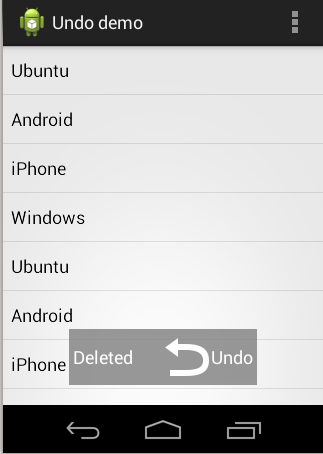
13. Performance Optimization
The following will implement a performance optimized version of the adapter from the previous example.
Create the following MyPerformanceArrayAdapter class.
package de.vogella.android.listactivity;
import android.app.Activity;
import android.view.LayoutInflater;
import android.view.View;
import android.view.ViewGroup;
import android.widget.ArrayAdapter;
import android.widget.ImageView;
import android.widget.TextView;
public class MyPerformanceArrayAdapter extends ArrayAdapter<String> {
private final Activity context;
private final String[] names;
static class ViewHolder {
public TextView text;
public ImageView image;
}
public MyPerformanceArrayAdapter(Activity context, String[] names) {
super(context, R.layout.rowlayout, names);
this.context = context;
this.names = names;
}
@Override
public View getView(int position, View convertView, ViewGroup parent) {
View rowView = convertView;
// reuse views
if (rowView == null) {
LayoutInflater inflater = context.getLayoutInflater();
rowView = inflater.inflate(R.layout.rowlayout, null);
// configure view holder
ViewHolder viewHolder = new ViewHolder();
viewHolder.text = (TextView) rowView.findViewById(R.id.TextView01);
viewHolder.image = (ImageView) rowView
.findViewById(R.id.ImageView01);
rowView.setTag(viewHolder);
}
// fill data
ViewHolder holder = (ViewHolder) rowView.getTag();
String s = names[position];
holder.text.setText(s);
if (s.startsWith("Windows7") || s.startsWith("iPhone")
|| s.startsWith("Solaris")) {
holder.image.setImageResource(R.drawable.no);
} else {
holder.image.setImageResource(R.drawable.ok);
}
return rowView;
}
}Use your new adapter in your activity. If you run the application it should look the same but it will be much faster, especially for large datasets.
package de.vogella.android.listactivity;
import android.app.ListActivity;
import android.os.Bundle;
public class MyListActivity extends ListActivity {
public void onCreate(Bundle icicle) {
super.onCreate(icicle);
String[] values = new String[] { "Android", "iPhone", "WindowsMobile",
"Blackberry", "WebOS", "Ubuntu", "Windows7", "Max OS X",
"Linux", "OS/2" };
setListAdapter(new MyPerformanceArrayAdapter(this, values));
}
}14. Tutorial: How to display two items in a ListView
You can use the SimpleAdapter class to show the data of two elements.
This class expects an Array of Strings (from data) in which the fields of the input data are defined.
It also requires an Array of ints which defines the IDs of the widgets in the layout for the row to which these fields are mapped.
The actual data is then a list of Maps.
The Map defines for each field in the from data a value.
The following shows an example which reuses a predefined layout from Android for the row.
package de.vogella.android.listactivity;
import java.util.ArrayList;
import java.util.HashMap;
import java.util.Map;
import android.app.ListActivity;
import android.os.Bundle;
import android.widget.SimpleAdapter;
public class MyTwoListItemsActivity extends ListActivity {
protected void onCreate(Bundle savedInstanceState) {
super.onCreate(savedInstanceState);
ArrayList<Map<String, String>> list = buildData();
String[] from = { "name", "purpose" };
int[] to = { android.R.id.text1, android.R.id.text2 };
SimpleAdapter adapter = new SimpleAdapter(this, list,
android.R.layout.simple_list_item_2, from, to);
setListAdapter(adapter);
}
private ArrayList<Map<String, String>> buildData() {
ArrayList<Map<String, String>> list = new ArrayList<Map<String, String>>();
list.add(putData("Android", "Mobile"));
list.add(putData("Windows7", "Windows7"));
list.add(putData("iPhone", "iPhone"));
return list;
}
private HashMap<String, String> putData(String name, String purpose) {
HashMap<String, String> item = new HashMap<String, String>();
item.put("name", name);
item.put("purpose", purpose);
return item;
}
}15. Selecting multiple items in the ListView
15.1. Interaction between the model and Listview
Frequently you need to select items in your ListView.
As the rows of the ListView are getting recycled you cannot store the selection on the View level.
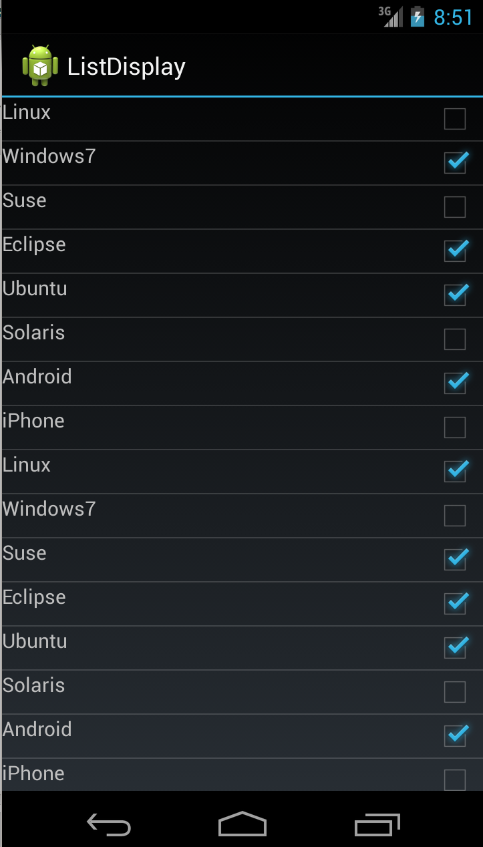
Selection is just one possible example but you can imagine other interaction between your row and model.
To persist the selection you have to update your data model with the selected state.
To update the data model in your ListView you define your own Adapter class.
In this adapter class you attach a listener to the View which is responsible for selecting the model element.
If selected, you update the state in the model which you can add as a tag to the View to have access to it.
The following example demonstrates how to use standard Java objects and how to interact from the Views with the model.
15.2. Tutorial: Domain Model and list view rows interaction
Continue to use the de.vogella.android.listactivity project.
Create the following Model which holds the name and the information if this element is currently selected.
package de.vogella.android.listactivity;
public class Model {
private String name;
private boolean selected;
public Model(String name) {
this.name = name;
selected = false;
}
public String getName() {
return name;
}
public void setName(String name) {
this.name = name;
}
public boolean isSelected() {
return selected;
}
public void setSelected(boolean selected) {
this.selected = selected;
}
}Create the following new layout file named rowbuttonlayout.xml.
<?xml version="1.0" encoding="utf-8"?>
<RelativeLayout xmlns:android="http://schemas.android.com/apk/res/android"
android:layout_width="match_parent"
android:layout_height="wrap_content" >
<TextView
android:id="@+id/label"
android:layout_width="wrap_content"
android:layout_height="wrap_content"
android:text="@+id/label"
android:textSize="30px" >
</TextView>
<CheckBox
android:id="@+id/check"
android:layout_width="wrap_content"
android:layout_height="wrap_content"
android:layout_alignParentRight="true"
android:layout_marginLeft="4px"
android:layout_marginRight="10px" >
</CheckBox>
</RelativeLayout>Create the following Adapter.
This adapter adds a listener on the Checkbox view.
If the checkbox is selected the underlying data of the model is changed.
Checkbox gets the corresponding model element assigned via the getTag() method.
package de.vogella.android.listactivity;
import java.util.List;
import android.app.Activity;
import android.view.LayoutInflater;
import android.view.View;
import android.view.ViewGroup;
import android.widget.ArrayAdapter;
import android.widget.CheckBox;
import android.widget.CompoundButton;
import android.widget.TextView;
public class InteractiveArrayAdapter extends ArrayAdapter<Model> {
private final List<Model> list;
private final Activity context;
public InteractiveArrayAdapter(Activity context, List<Model> list) {
super(context, R.layout.rowbuttonlayout, list);
this.context = context;
this.list = list;
}
static class ViewHolder {
protected TextView text;
protected CheckBox checkbox;
}
@Override
public View getView(int position, View convertView, ViewGroup parent) {
View view = null;
if (convertView == null) {
LayoutInflater inflator = context.getLayoutInflater();
view = inflator.inflate(R.layout.rowbuttonlayout, null);
final ViewHolder viewHolder = new ViewHolder();
viewHolder.text = (TextView) view.findViewById(R.id.label);
viewHolder.checkbox = (CheckBox) view.findViewById(R.id.check);
viewHolder.checkbox
.setOnCheckedChangeListener(new CompoundButton.OnCheckedChangeListener() {
@Override
public void onCheckedChanged(CompoundButton buttonView,
boolean isChecked) {
Model element = (Model) viewHolder.checkbox
.getTag();
element.setSelected(buttonView.isChecked());
}
});
view.setTag(viewHolder);
viewHolder.checkbox.setTag(list.get(position));
} else {
view = convertView;
((ViewHolder) view.getTag()).checkbox.setTag(list.get(position));
}
ViewHolder holder = (ViewHolder) view.getTag();
holder.text.setText(list.get(position).getName());
holder.checkbox.setChecked(list.get(position).isSelected());
return view;
}
}Finally change your activity to the following.
package de.vogella.android.listactivity;
import java.util.ArrayList;
import java.util.List;
import android.app.ListActivity;
import android.os.Bundle;
import android.widget.ArrayAdapter;
public class MyList extends ListActivity {
/** Called when the activity is first created. */
public void onCreate(Bundle icicle) {
super.onCreate(icicle);
// create an array of Strings that will be put to our ListActivity
ArrayAdapter<Model> adapter = new InteractiveArrayAdapter(this,
getModel());
setListAdapter(adapter);
}
private List<Model> getModel() {
List<Model> list = new ArrayList<Model>();
list.add(get("Linux"));
list.add(get("Windows7"));
list.add(get("Suse"));
list.add(get("Eclipse"));
list.add(get("Ubuntu"));
list.add(get("Solaris"));
list.add(get("Android"));
list.add(get("iPhone"));
// Initially select one of the items
list.get(1).setSelected(true);
return list;
}
private Model get(String s) {
return new Model(s);
}
}If you start your app you should be able to flag items. These changes will be reflected in your model.
16. Implementing an expandable ListView
16.1. ExpandableListView
The ExpandableListView is similar to ListView, but allows you to define groups and details for this group.
ExpandableListView expects an adapter of type BaseExpandableListAdapter.
In this case you have to define two layouts, one for the group and another one for the details row.
16.2. ExpandableListView example
In the following example you create an expandable listview similar to the following screenshot.
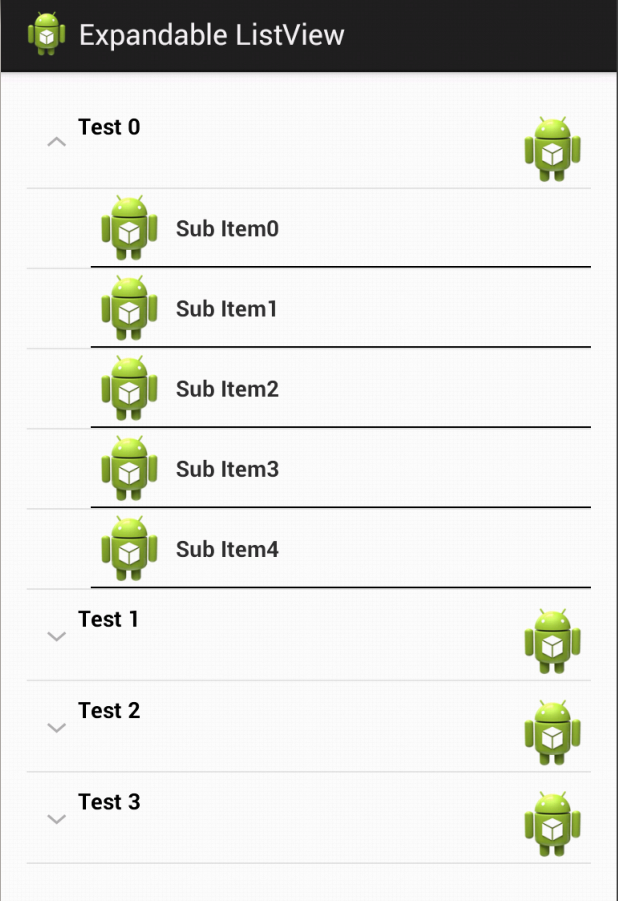
Create a project called com.vogella.android.listview.expandable with the activity called MainActivity.
Create or adjust the following layout files. First layout/activity_main.xml.
<LinearLayout xmlns:android="http://schemas.android.com/apk/res/android"
xmlns:tools="http://schemas.android.com/tools"
android:id="@+id/LinearLayout1"
android:layout_width="match_parent"
android:layout_height="match_parent"
tools:context=".MainActivity" >
<ExpandableListView
android:id="@+id/listView"
android:layout_width="match_parent"
android:layout_height="wrap_content" >
</ExpandableListView>
</LinearLayout>Afterwards, create layout/listrow_group.xml.
<CheckedTextView xmlns:android="http://schemas.android.com/apk/res/android"
xmlns:tools="http://schemas.android.com/tools"
android:id="@+id/textView1"
android:layout_width="wrap_content"
android:layout_height="?android:attr/listPreferredItemHeight"
android:layout_marginLeft="8dp"
android:drawableRight="@drawable/ic_launcher"
android:gravity="left"
android:paddingLeft="32dp"
android:paddingTop="8dp"
android:text="Test"
android:textSize="14sp"
android:textAlignment="textEnd"
android:textStyle="bold" />The last required layout is layout/listrow_details.xml.
<LinearLayout xmlns:android="http://schemas.android.com/apk/res/android"
xmlns:tools="http://schemas.android.com/tools"
android:layout_width="match_parent"
android:layout_height="40dp"
android:clickable="true"
android:orientation="vertical"
android:paddingLeft="40dp"
tools:context=".MainActivity" >
<TextView
android:id="@+id/textView1"
android:layout_width="wrap_content"
android:layout_height="wrap_content"
android:drawableLeft="@drawable/ic_launcher"
android:drawablePadding="5dp"
android:gravity="center_vertical"
android:text="@string/hello_world"
android:textSize="14sp"
android:textStyle="bold" >
</TextView>
<View
android:layout_width="match_parent"
android:layout_height="1dp"
android:background="@android:color/black" />
</LinearLayout>Create the following class which holds your domain model for the ExpandableListView.
package com.vogella.android.listview.expandable;
import java.util.ArrayList;
import java.util.List;
public class Group {
public String string;
public final List<String> children = new ArrayList<String>();
public Group(String string) {
this.string = string;
}
}Finally create the adapter as described by the following listing and change the activity to the code provided below.
package com.vogella.android.listview.expandable;
import android.app.Activity;
import android.util.SparseArray;
import android.view.LayoutInflater;
import android.view.View;
import android.view.View.OnClickListener;
import android.view.ViewGroup;
import android.widget.BaseExpandableListAdapter;
import android.widget.CheckedTextView;
import android.widget.TextView;
import android.widget.Toast;
public class MyExpandableListAdapter extends BaseExpandableListAdapter {
private final SparseArray<Group> groups;
public LayoutInflater inflater;
public Activity activity;
public MyExpandableListAdapter(Activity act, SparseArray<Group> groups) {
activity = act;
this.groups = groups;
inflater = act.getLayoutInflater();
}
@Override
public Object getChild(int groupPosition, int childPosition) {
return groups.get(groupPosition).children.get(childPosition);
}
@Override
public long getChildId(int groupPosition, int childPosition) {
return 0;
}
@Override
public View getChildView(int groupPosition, final int childPosition,
boolean isLastChild, View convertView, ViewGroup parent) {
final String children = (String) getChild(groupPosition, childPosition);
TextView text = null;
if (convertView == null) {
convertView = inflater.inflate(R.layout.listrow_details, null);
}
text = (TextView) convertView.findViewById(R.id.textView1);
text.setText(children);
convertView.setOnClickListener(new OnClickListener() {
@Override
public void onClick(View v) {
Toast.makeText(activity, children,
Toast.LENGTH_SHORT).show();
}
});
return convertView;
}
@Override
public int getChildrenCount(int groupPosition) {
return groups.get(groupPosition).children.size();
}
@Override
public Object getGroup(int groupPosition) {
return groups.get(groupPosition);
}
@Override
public int getGroupCount() {
return groups.size();
}
@Override
public void onGroupCollapsed(int groupPosition) {
super.onGroupCollapsed(groupPosition);
}
@Override
public void onGroupExpanded(int groupPosition) {
super.onGroupExpanded(groupPosition);
}
@Override
public long getGroupId(int groupPosition) {
return 0;
}
@Override
public View getGroupView(int groupPosition, boolean isExpanded,
View convertView, ViewGroup parent) {
if (convertView == null) {
convertView = inflater.inflate(R.layout.listrow_group, null);
}
Group group = (Group) getGroup(groupPosition);
((CheckedTextView) convertView).setText(group.string);
((CheckedTextView) convertView).setChecked(isExpanded);
return convertView;
}
@Override
public boolean hasStableIds() {
return false;
}
@Override
public boolean isChildSelectable(int groupPosition, int childPosition) {
return false;
}
}package com.vogella.android.listview.expandable;
import java.util.ArrayList;
import android.app.Activity;
import android.os.Bundle;
import android.util.SparseArray;
import android.view.Menu;
import android.widget.ExpandableListView;
public class MainActivity extends Activity {
// more efficient than HashMap for mapping integers to objects
SparseArray<Group> groups = new SparseArray<Group>();
@Override
protected void onCreate(Bundle savedInstanceState) {
super.onCreate(savedInstanceState);
setContentView(R.layout.activity_main);
createData();
ExpandableListView listView = (ExpandableListView) findViewById(R.id.listView);
MyExpandableListAdapter adapter = new MyExpandableListAdapter(this,
groups);
listView.setAdapter(adapter);
}
public void createData() {
for (int j = 0; j < 5; j++) {
Group group = new Group("Test " + j);
for (int i = 0; i < 5; i++) {
group.children.add("Sub Item" + i);
}
groups.append(j, group);
}
}
}17. Tutorial: Miscellaneous
17.1. Adding a longclick listener to the list items
You can also add a LongItemClickListener to the list view via the setOnItemLongClickListener() method.
package de.vogella.android.listactivity;
import android.widget.AdapterView.OnItemLongClickListener;
public class MyList extends Activity {
/** Called when the activity is first created. */
public void onCreate(Bundle icicle) {
super.onCreate(icicle);
// configure your list view as before
// ListView is assigned to local variable list...
list.setOnItemLongClickListener(new OnItemLongClickListener() {
@Override
public boolean onItemLongClick(AdapterView<?> parent, View view,
int position, long id) {
Toast.makeText(MyList.this,
"Item in position " + position + " clicked",
Toast.LENGTH_LONG).show();
// Return true to consume the click event. In this case the
// onListItemClick listener is not called anymore.
return true;
}
});
}
}17.2. Header and footer
You can of course put arbitrary views elements around your list view.
For example, you can define a layout with two text views and a list view between them.
In this case the two text views will always be visible above the list (header) and the other will be visible below the list.
If you want to display a list header or list footer only at the beginning or end of the list you can use the addHeaderView() method or addFooterView() method on the ListView class.
// configuration as before
ListView listView = (ListView) findViewById(R.id.list);
View header = getLayoutInflater().inflate(R.layout.header, null);
View footer = getLayoutInflater().inflate(R.layout.footer, null);
listView.addHeaderView(header);
listView.addFooterView(footer);
listView.setAdapter(new ArrayAdapter<String>(this,
android.R.layout.simple_list_item_single_choice,
android.R.id.text1, names));
}
}18. SimpleCursorAdapter
In case you work with a content provider or directly with the database you can use the SimpleCursorAdapter to define the data for your ListView.
The following will demonstrate how to access the Contacts ContentProvider.
Create a new Android project called "de.vogella.android.listactivity.cursor" with the activity called MyListActivity.
Change MyListActivity to the following.
package de.vogella.android.listactivity.cursor;
import android.app.ListActivity;
import android.database.Cursor;
import android.net.Uri;
import android.os.Bundle;
import android.provider.ContactsContract;
import android.widget.ListAdapter;
import android.widget.SimpleCursorAdapter;
public class MyListActivity extends ListActivity {
/** Called when the activity is first created. */
@Override
public void onCreate(Bundle savedInstanceState) {
super.onCreate(savedInstanceState);
Cursor mCursor = getContacts();
startManagingCursor(mCursor);
// now create a new list adapter bound to the cursor.
// SimpleListAdapter is designed for binding to a Cursor.
ListAdapter adapter = new SimpleCursorAdapter(this, // Context.
android.R.layout.two_line_list_item, // Specify the row template
// to use (here, two
// columns bound to the
// two retrieved cursor
// rows).
mCursor, // Pass in the cursor to bind to.
// Array of cursor columns to bind to.
new String[] { ContactsContract.Contacts._ID,
ContactsContract.Contacts.DISPLAY_NAME },
// Parallel array of which template objects to bind to those
// columns.
new int[] { android.R.id.text1, android.R.id.text2 });
// Bind to our new adapter.
setListAdapter(adapter);
}
private Cursor getContacts() {
// Run query
Uri uri = ContactsContract.Contacts.CONTENT_URI;
String[] projection = new String[] { ContactsContract.Contacts._ID,
ContactsContract.Contacts.DISPLAY_NAME };
String selection = ContactsContract.Contacts.IN_VISIBLE_GROUP + " = '"
+ ("1") + "'";
String[] selectionArgs = null;
String sortOrder = ContactsContract.Contacts.DISPLAY_NAME
+ " COLLATE LOCALIZED ASC";
return managedQuery(uri, projection, selection, selectionArgs,
sortOrder);
}
}Make sure you give your application the permission to read the contacts (Uses Permissions "android.permission.READ_CONTACTS" in AndroidManifest.xml).
19. Additional Open Source libraries
Sometimes having to press a refresh button on the ActionBar to refresh data can be annoying for the user.
Chris Banes has implemented an open-source library to implement the pull to refresh pattern for a Listview.
See https://github.com/chrisbanes/Android-PullToRefresh.
Also you may want to use the swipe to dismiss gesture to delete items from a ListView. Roman Nurik provides an example for this at Android swipe-to-dismiss library which Jake Wharton backported to earlier Android releases at SwipeToDismissNOA.
20. resources_listview
20.2. vogella Java example code
If you need more assistance we offer Online Training and Onsite training as well as consulting

